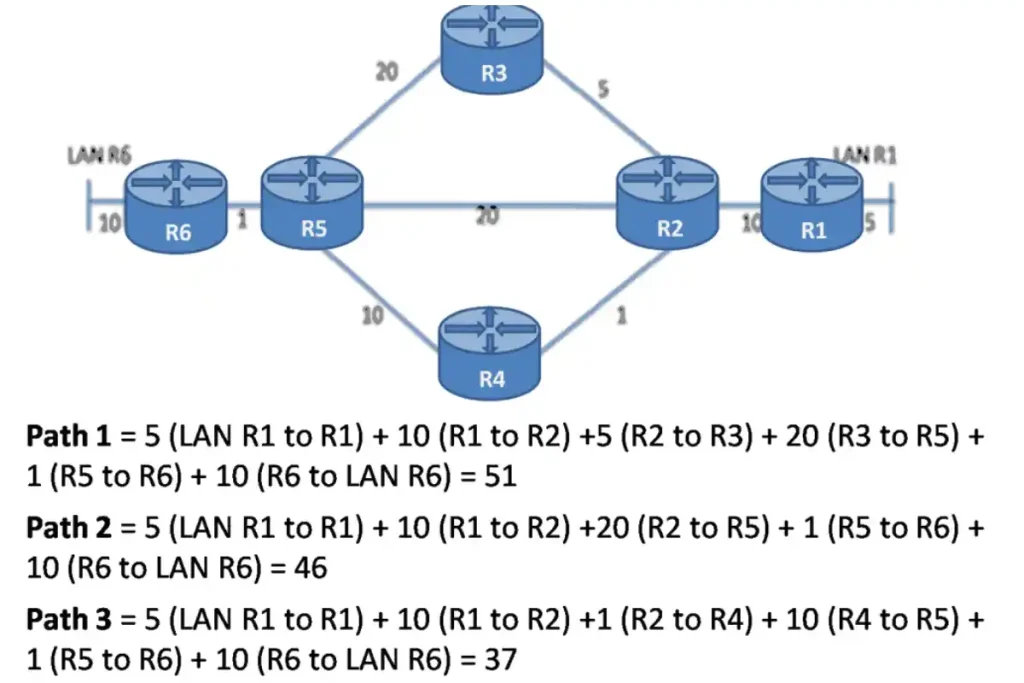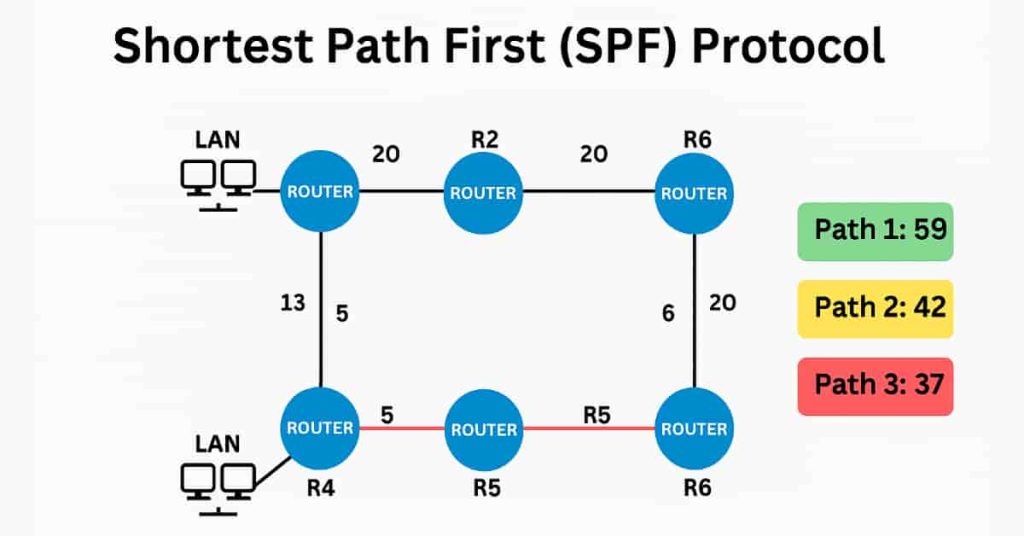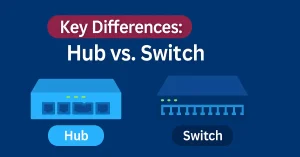In networking, efficient routing is crucial for data transmission across complex topologies. The Shortest Path First (SPF) Protocol, also known as Link-State Routing, uses Edsger Dijkstra’s SPF Algorithm to determine the optimal path for packets. Protocols like Open Shortest Path First (OSPF) and Intermediate System-to-Intermediate System (IS-IS) are prime examples of link-state routing protocols. These protocols are more complex than distance vector routing protocols like RIP, offering faster convergence and better scalability for enterprise networks.
To help CCNA students grasp the differences quickly, here’s a comparison table between link-state and distance vector protocols:
| Feature | Link-State (e.g., OSPF/IS-IS) | Distance Vector (e.g., RIP) |
|---|---|---|
| Algorithm | Dijkstra’s SPF | Bellman-Ford |
| Convergence | Faster (event-driven) | Slower (periodic updates) |
| Scalability | High (hierarchical) | Low (flat) |
| CPU/Memory Usage | Higher | Lower |
| Metric | Cost (bandwidth-based) | Hop count |
Dijkstra’s Algorithm
Dijkstra’s algorithm was published in 1959. OSPF (Open Shortest Path First) and IS-IS (Intermediate System-to-Intermediate System) protocols use Dijkstra’s algorithm to calculate the best path from a source to a destination. Dijkstra’s algorithm is usually called the shortest path first (SPF) algorithm. The algorithm uses the addition of costs along each path, from source to destination, to determine the total cost of a route. The route with the lowest cost is selected as the best.
For a deeper understanding, especially for CCNP exam prep, here’s a step-by-step breakdown of how Dijkstra’s algorithm works in routing:
Repeat: Continue until all nodes are visited or no updates are possible.
Initialize: Set the distance to the source router as 0 and to all other routers as infinity. Create a set of unvisited nodes (all routers in the topology).
Select Node: Choose the unvisited node with the smallest known distance from the source.
Update Neighbors: For the selected node, calculate the distance to its neighbors. If a shorter path is found through this node, update the distance.
Mark Visited: Mark the node as visited and remove it from the unvisited set.
Shortest Path First Protocol (SPF) Example
The link between each router is labelled in the figure below with a cost value. There are three paths from R1 LAN to R6 LAN and vice versa. The figure shows that the lowest cost is 37, so this is the shortest path for sending data between LAN R1 and LAN R6. Each router containing the SPF (Shortest Path First) Algorithm determines its own cost to each destination in the topology.

If you notice that path 2 has the least hop count, but the shortest path is path 3; the cost to reach R2 to R5 is 20 and higher than the cost from R2 to R5 through R4, which is 11.
Pros and Cons of Link-State Protocols
Link-state protocols like OSPF and IS-IS offer several advantages for modern networks:
- Pros:
- Fast Convergence: Event-triggered updates mean changes propagate quickly, reducing downtime.
- Loop-Free Routing: Full topology awareness via LSDB prevents loops.
- Scalability: Hierarchical design with areas (in OSPF) or levels (in IS-IS) suits large enterprises.
- Support for VLSM and CIDR: Ideal for efficient IP addressing.
- Cons:
- High Resource Usage: Requires more CPU and memory to maintain LSDB and run SPF calculations.
- Complexity: Configuration and troubleshooting are more involved than RIP.
- Flooding Overhead: Link-state advertisements (LSAs in OSPF) can consume bandwidth if not tuned.
For CCNP students, note that OSPF uses areas to mitigate these cons, while IS-IS is often preferred in service provider networks for its extensibility.
OSPF vs. IS-IS: A Comparison for CCNP
While both use Dijkstra’s SPF, there are differences:
- OSPF: IPv4/IPv6 specific, uses areas (backbone Area 0 mandatory), more common in enterprise environments.
- IS-IS: Protocol-independent (CLNS-based), uses levels (L1/L2), better for very large-scale deployments like ISPs.
CCNP tip: IS-IS doesn’t require a backbone area, making it more flexible for migrations.
OSPF Packet Types and Convergence
To expand on basics, OSPF relies on five packet types for operation:
- Hello: Discovers neighbors and forms adjacencies.
- Database Description (DBD): Summarizes LSDB.
- Link-State Request (LSR): Requests specific LSAs.
- Link-State Update (LSU): Floods LSAs.
- Link-State Acknowledgment (LSAck): Confirms receipt.
Convergence happens when all routers synchronize their LSDBs and run SPF. In case of a link failure, LSAs flood, triggering partial SPF recalculations for efficiency.
FAQs
What is the Shortest Path First (SPF) protocol?
SPF, also known as link-state routing, uses Dijkstra’s algorithm to find optimal paths in networks. Protocols like OSPF and IS-IS build topology maps for fast convergence and scalability, outperforming distance vector like RIP in large setups.
How does Dijkstra’s algorithm work in OSPF?
It initializes distances from the source, selects the nearest unvisited node, updates neighbor costs if shorter, and repeats until all nodes are processed. This builds a shortest path tree using link costs, ensuring loop-free routes in OSPF.
What are the pros and cons of link-state protocols?
Pros include fast event-driven convergence, scalability via areas, and VLSM support. Cons are high CPU/memory usage and a complex setup. OSPF suits enterprises, while IS-IS excels in large ISPs due to its flexibility.
How do you verify OSPF configuration on a router?
Use commands like show ip ospf neighbor for adjacencies, show ip ospf database for LSDB, and show ip route ospf for routes. Debug ip ospf adj helps troubleshoot adjacency issues in CCNA/CCNP labs.





